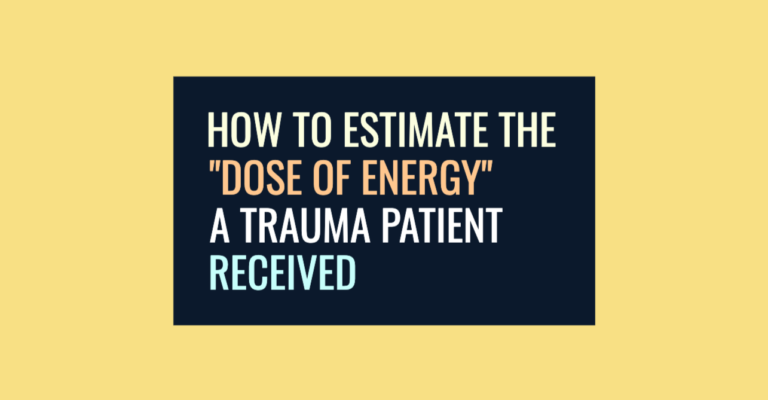Like any other disease, trauma has a recognizable etiology, pathophysiology and set of risk factors. But the causative agent in trauma isn’t a microorganism, atherosclerotic plaque, cancer cell or toxin — it’s energy.

Chief Clinical Officer of TCAR Education Programs
Energy is the pathogen in the disease called trauma, which may be a perspective on injury that is new to you. Although acquiring a traumatic injury often takes seconds instead of minutes, hours, days, weeks, months, years or even decades, its course is no less predictable than that of other diseases. We can predict who will be injured, how they will be injured, what injuries they are likely to sustain and what their outcome will be.
If energy is the pathogen in trauma, then analyzing the forces involved in a patient’s injuries is not just an academic exercise. It’s crucial to trauma patient assessment and management, both initially and well beyond the early resuscitation phase.
Fortunately, analyzing injury potential is not as daunting as it might sound. We can evaluate any patient’s injury potential by examining four fundamental factors.
- First, the nature and amount of force: the dose of energy involved.
- Second, various patient characteristics. What is it about this individual — who he is and what he does — that predicts injury and outcome?
- The third predictor of injury potential involves the characteristics of the wounding agent: the type of energy and how it was applied to the tissues.
- And the last important factor to consider when analyzing injury potential is tissue characteristics. What injuries can I predict based on an understanding of the specific tissues involved?
All four of these factors are examined in detail in the Trauma Care After Resuscitation (TCAR) course. (To learn more about this online, self-paced course, visit TCAR Education Programs). In this article, I will focus on the first step in analyzing injury potential — identifying the amount of force.
First, a physics lesson
What was the dose of energy a patient potentially received, and where did it go? Sir Isaac Newton was the first to assert that kinetic energy is equal to mass times velocity squared, divided by 2 (or Energy = M x V2/2).
As you will recall from your secondary school physics class, mass and weight are not precisely the same. But for trauma care purposes, we can employ an abbreviated, clinically useful version of this formula: force equals weight times speed squared, with the whole equation divided by 2. But that “divided by 2” part of the formula is a mathematical constant. It never varies. Therefore, we can leave it out of our mental equation and simply say:
Force = Weight x Speed2
Conceptualizing force is critical because force is the “dose” of energy involved. If you were caring for an acetaminophen overdose patient, your first question would be, “What was the dose of Tylenol ingested?” Similarly, the initial step in analyzing injury potential is to ask, “What was the dose of energy involved?”
The effect of weight is linear
Let’s conceptualize energy dose using the simplified formula highlighted above: Force = Weight x Speed2. The effect of weight in this equation is linear: as weight increases, force increases in direct proportion.
Which means being stepped on by a 2-ton elephant is twice as much force as being stepped on by a 1-ton elephant and half as much force as being stepped on by a 4-ton elephant.
Occasionally, patients encounter a very large mass. What’s the weight of a train? Hundreds of tons How fast does the train need to be moving when it strikes a car in order to do major damage? Not very fast at all. Likewise, when a small child encounters a large truck, the mass is very significant. Force is great, even when hit at a low speed. And, predictably, the bigger mass wins these encounters.
But the effect of speed is exponential
Nevertheless, speed is the more significant part of the force equation in most trauma scenarios. As weight increases, force (the energy dose) increases in direct proportion. However, the effect of speed in the force equation is exponential (it’s squared). Thus, even small changes in velocity can make a major difference in the dose of energy involved.
For example, a vehicle traveling 50 miles per hour (mph) hits a fixed object. Square 50 and you get 2,500 units of kinetic energy. Now, take the same-weight car, moving 70 mph into the same fixed object. Square 70, and you get 4,900 units of kinetic energy. That’s an increase of only 40% in velocity, but it results in almost a 100% increase in the force involved. This explains why the odds of being killed or severely injured in a crash double for every 10 miles per hour traveled over 50 mph.
Therefore, how fast a patient was moving at the time of impact is critical to our trauma assessment. We frequently don’t know the precise speed involved but never think, “50, 60, 70, what’s the difference?” The difference is enormous. And that’s vital information trauma care providers need to know.
Yet the problem is not the speed, it’s the stop
To be clear, going fast is not really the problem. It’s not the speed but the stop that kills because the stop is when energy is applied to the tissues.
Therefore, both speed and deceleration distance are essential components of injury analysis. Deceleration distance is significant because it allows energy to dissipate — to go somewhere else — rather than to vehicle occupants.
For example, if a car is traveling at 50 mph when it hits a telephone pole, it will decelerate from 50 to 0 mph in the space of a few feet as the front end of the car is compressed. Compare that to another vehicle traveling at 50 mph that side-swipes a car and spins around twice before stopping 200 feet from the original impact. In the second event, there is considerably more distance for energy to dissipate away from vehicle occupants.
Airbags work because they add deceleration distance, providing occupants an extra 12 or more inches to dissipate energy instead of going from 50 to zero against the steering wheel, seats, vehicle frame or windshield. In addition to keeping passengers in the seat and in the vehicle during a collision, seat belts work because they add deceleration distance. Motor vehicle restraint systems are designed to have just a bit of stretch, so passengers can “ride down” the energy force instead of coming to an abrupt stop.
Even safety devices outside a vehicle (e.g., water-filled crash barriers) work because they add deceleration distance compared to steel or concrete road dividers. And deceleration distance is not just about cars. Safe playground surfaces work because they add deceleration distance; even that tiny amount is significant. Similarly, padded helmets work because they, too, add deceleration distance. Their ability to give just a little makes all the difference by deflecting energy away from the skull.
How to apply these principles to trauma care
Which brings us to another law of physics: Energy cannot be created or destroyed, only changed. Or to put this law into plain English: The force went somewhere. Energy doesn’t just disappear, so where did it go? Our job as trauma care providers is to identify how much energy was potentially involved — high, medium or low — and then look for where that energy was transferred to our patient.
- Some indicators of force are readily apparent on physical exam and are rarely missed in the emergency department (for example, a depressed skull fracture or a major orthopedic injury). It is the job of the trauma resuscitation team to identify and address these obvious and life-threatening injuries.
- But other indicators of force (like periorbital bruising or pulmonary contusions) may not show up for hours or days.
- And some subtle indicators of force (such as cervical strain, non-displaced fractures, soft tissue trauma and some brain injuries) may not be evident for days or weeks.
It’s up to post-resuscitation care providers to find these delayed and subtle injuries. But you must be looking for them. And that requires an understanding and careful consideration of the energy involved.
Begin by visualizing the mechanism of injury
Forming a mental picture of the event helps evaluate both how much force was involved and where it went.
Once they reach the ED (let alone our inpatient units) most blunt trauma patients appear pretty much alike. Looking at a fall patient, it may be impossible to determine whether he tripped over a curb or jumped out of a second-floor window. Learning a patient was involved in a motor vehicle collision tells me very little. Was the crash a fender-bender? Or was the vehicle wrapped around a tree?
Emergency care providers can usually get MOI information from EMS personnel and sometimes from law enforcement officers. Post-acute providers can access this information in the EMR (if recorded). In addition, useful information can often be obtained from family members or the patient themself.
After visualizing the mechanism of injury, use this mental picture to inform your patient assessment and care.
When caring for trauma patients, we do not just treat the injuries we see. We also treat the injuries we expect to see by analyzing the factors involved. For instance, you are caring for a patient who was in a car crash. One day post-injury, your patient becomes a little short of breath and her oxygen saturation level starts to drop.
- If you are not thinking in terms of the dose of energy involved in this injury, you might not know where to start with your assessment.
- If you have identified the energy involved in this injury and other factors, you will have a better idea of what is happening with this patient. In this scenario, knowing that the patient was an unrestrained driver who hit the steering wheel will alert you to the possibility of pulmonary contusion.
Expert post-resuscitation trauma care is all about learning to anticipate injuries. We are much less likely to miss wounds and complications if we can predict them.
Laura M. Criddle, PhD, RN, TCRN, FAEN is chief clinical officer of TCAR Education Programs. The TCAR course was specifically created to meet the learning needs of inpatient trauma nurses. It offers emergency, perioperative, critical care, acute care and rehabilitation providers the foundational, evidence-based information and clinical reasoning skills necessary to address the needs of the hospitalized trauma patient. Find out more at TCAR Education Programs.


1 Comment
I am doing TCAR course and I have to say that I am impressed with how good it is. Great clinical content combined with an amazing lecture.
Highly reccommended.